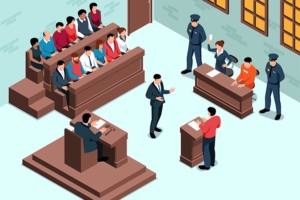In brief, here’s how jury selection works:
Potential jurors are assigned numbers prior to entering the courtroom. The lower your number, the more likely you are to be picked for a jury because if you are not bumped for cause or a preemptory challenge, and if there are still seats on the panel and there is no juror with a lower number ahead of you who has yet to be dismissed or accepted, the lawyers have to take you on the case.
The lawyers and the judge can dismiss anyone for cause without limitations. Cause challenges can be for medical reasons, professional reasons, and personal reasons. Cause challenges can also be made because of expressed or apparent bias or prejudice that lead one party or both to the action to conclude you could not fairly hear the case. In my last sex crime trial, I think a dozen jurors were dismissed for cause by personally expressing they could not be fair in such a trial or – without saying it – led everyone to feel so.
Once all the challenges for cause are made, each party to the dispute has a limited number of preemptory challenges. In Superior Court, each side gets 6 preemptory challenges, with half as much in District or Municipal Court. Preemptory challenges, historically, could be used to bump anyone for any reason without limitation or required explanation. Since 1986 however, there has been one exception.
Batson v. Kentucky, 476 U.S. 79 (1986), was a case in which the United States Supreme Court ruled that a prosecutor may not use of peremptory challenge in a criminal case to exclude jurors based solely on their race. Defense attorneys are thus trained that if they suspect that prosecutors are attempting to eliminate brown and black people from the jury, to make a “Batson challenge” to the prosecutor’s preemptory challenge.
In practice however, this is an awkward/difficult thing to do as a defense attorney because what effectively you are saying – on the record – is the guy who you see every day in court is a racist (or at least, using racism to mess with the jury). That might not seem like much in the age of “check your privilege” Facebook fights but many white people take this very personally – including prosecutors who believe they’re the good guys in this fight. And generally speaking, although we are adversaries, most of our conflicts are not personal.
To make things worse, historically, to defeat a Batson challenge, all a prosecutor had to do was provide a non-race-based reason for why they were removing the juror in question. It didn’t need to be a good reason, just not-race-based.
So, for example, popular explanations prosecutors offer for why they disproportionally raise objections to people of color serving on a jury(all white jury or black jury) include:
- They disproportionally express lack of faith in law enforcement or in the criminal justice system, and are therefore deemed not to be able to be fair.
- They disproportionally admit that close friends or family of theirs have been arrested, and are therefore deemed to be too much of a risk to the State.
- The juror’s professional life raised concerns for the prosecutor (in general, prosecutors are afraid to have teachers and pastors/spiritual leaders serve on a jury, regardless of their race).
- The juror in question failed to make eye contact with the prosecutor or made too much eye contact. They kept their arms folded in such a way that they led the prosecutor to believe they could not be fair, etc.
Historically, all of these explanations have been sufficient to survive a Batson challenge. The end result of this and other problems with jury selection is that many people of color get tried by all white jury, even in comparatively diverse communities like Tacoma.
WHY IS THIS A PROBLEM
It is no secret that the criminal justice system disproportionately affects people of color, many of whom are innocent, with many more being less guilty than the State alleges. Many want their day in court, but are convinced they will not get a fair shot when they get there.
As a white attorney, I cannot express to readers what it is like when your thirty-something black or brown client watches the last minority in the jury pool get bumped, in favor of a panel comprised of twelve housewives, state employees and retired Boeing engineers…all of whom are white. You can feel the energy go out of them, like they already lost, and at that point your job as the defense attorney is to get your client’s head up and focus on the task ahead.
(For the record, I have repeatedly secured “not guilty” verdicts for people of color before all white jury).
This presents a problem that cannot be corrected by putting more minorities on the bench or in the prosecutor’s office.
WHAT CAN BE DONE
The good news is that on April 5, 2018, the Washington Supreme Court adopted General Rule 37 that is going to make it significantly more difficult for all attorneys to bump people of color on preemptory challenges by making several of the previous arguments prosecutors have made to exclude minority jurors under Batson challenges “presumptively invalid.” Also, the new standard requires that the Court “evaluate the reasons given to justify the preemptory challenge in light of the totality of circumstances. If the court determines that an objective observer could view race or ethnicity as a factor in the use of the peremptory challenge, then the preemptory challenge is denied. The court need not find purposeful discrimination to deny the preemptory challenge.” GR 37(e)
This is a badass rule that I believe will go a long way to effect my side’s cause, but it’s not enough.
We also need to address the way courts call people for jury duty.
Most jurisdictions pull jurors from lists gathered by driver licenses and voter registrations and this – by default – results in more economically stable and older people being called for jury duty (and you can guess what color they are).
To make matters worse, in the name of “judicial economy” courts tend to call the exact same people for jury duty again and again. This is because if you know that someone showed up once, you can presume they – if called – will show up again. That means that fewer notices for jury duty need to be sent out to get a panel to choose from, because you can predict who will appear. However, because minorities are disproportionately excluded from jury duty, they don’t show up again as often, which means the jury pool is always disproportionally white.
My wife, white, has been called for jury duty 5 times in Tacoma and was picked twice I think (all before I became a defense attorney, now she always gets excused). One person I know (also white) claims to have been called for jury duty 9 times in the past 30 years. I doubt you could find anyone of color who has been called for jury duty 9 times.
Most importantly, if called to jury duty, you need to show up.
We especially need young people to show up (as all my interns have promised they would), regardless of their race. But yes, if you identify as a racial minority and fail to respond to jury duty, that decision may be especially devastating for someone who may be risking a lot to assert their innocence.
But again, everyone should show up. Even if you suspect you would be bumped on a preemptory challenge, remember – those are limited, and if the other side has to use one on you, that means that someone else they wouldn’t have wanted either is likely to get on.
The truth is, despite the wonderful step taken recently by our Supreme Court, the systemic removal of people of color from juries over many generations will likely continue to frustrate efforts to diversify the racial makeup of our juries. But what we might be witnessing today is the beginning of the end.




